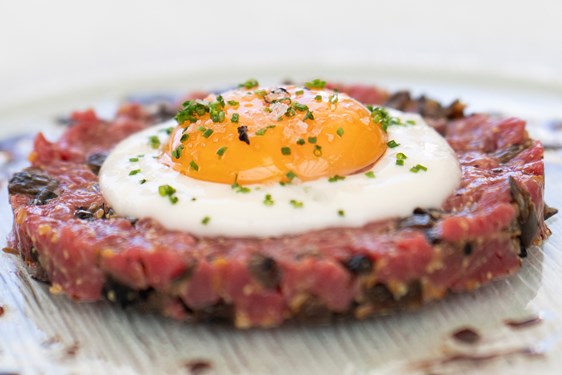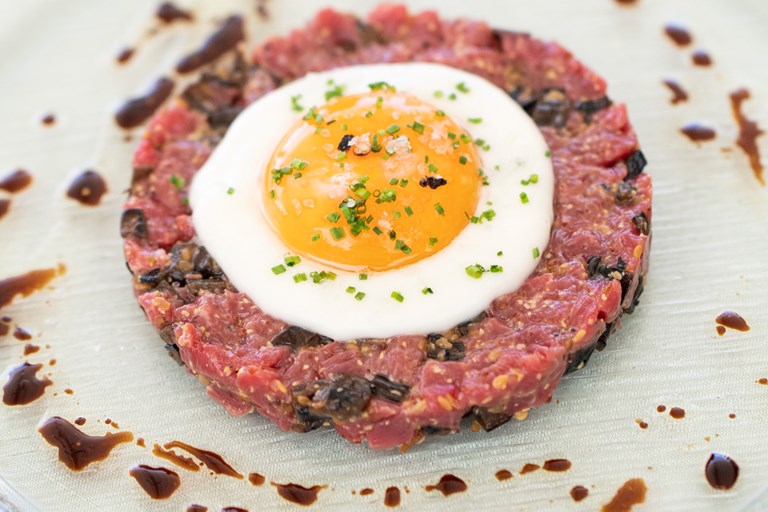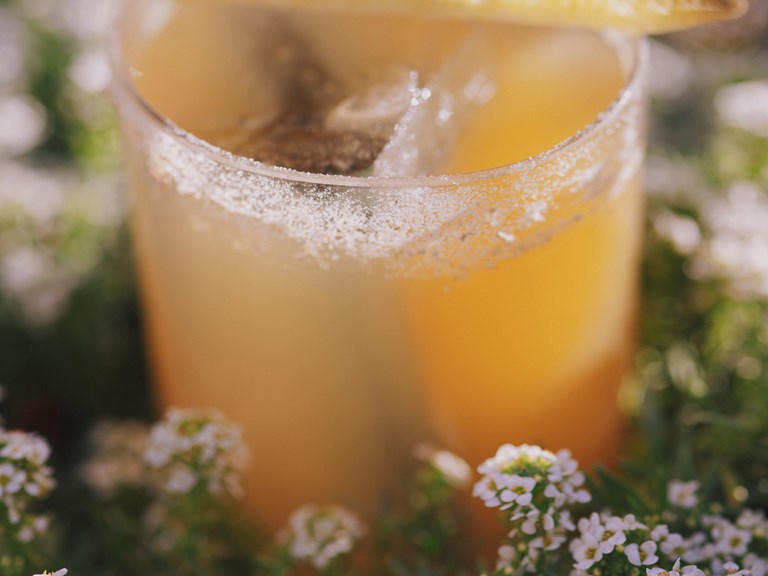RECIPE: BEEF TARTARE, POSITANO STYLE
02.10.2022 RECIPES
It has a lot more to do with the advent of modern food hygiene regulations that made raw meat a safe and available ingredient for chefs and restaurateurs. Its rise is also linked to the health cults of the early 20th century, a time when steak tartare’s undoubted health benefits also became associated with male virility. Raw beef and eggs – what could be more macho?
When it emerged in France at the end of the 19th century, steak tartare was known as “à l’americaine” or ‘American-style’ – possibly because it was adapted from Hamburg steak, a dish of lightly smoked beef served in restaurants in the port of New York, or possibly because slathering meat with condiments was considered to be an American sport. (In Belgium, steak tartare is still known as filet à l’americaine).
However, as one of these condiments was tartare sauce (a flavoured mayonnaise made with the addition of hard-boiled egg yolks, onions, chives and other ingredients), the raw meat dish soon took on the name of its chief accompaniment. Ironically, tartare sauce is not generally served with steak tartare today, even in France. The other difference in those early days is that the meat used was almost always horsemeat (boucheries chevalins or horsemeat butchers still exist in France, though they are less widespread than they once were).
Nowadays, the classic French style of steak tartare involves Dijon mustard, chopped shallots and capers, raw egg yolk and Worcestershire sauce. But this is an eminently adaptable dish, one that lends itself to regional variations based on local traditions and the availability of seasonal ingredients.
The version presented here is Le Sirenuse’s executive chef Gennaro Russo’s light southern Mediterranean spin on steak tartare. The most obvious addition is that summer staple of the cuisine of Naples and southern Italy – the eggplant or aubergine. But there’s also a striking absence. For Gennaro, the addition of mustard covers the delicate taste of the raw beef. Once, he says, when raw meat was not always guaranteed fresh from the farm, this may have been advisable – but today, if supplied by a reputable butcher, good grass-fed beef needs no such disguise. Gennaro’s version also includes a playful trompe l’oeil topping – a ‘fried egg’ which is in fact an egg yolk sitting inside a ring of provolone cheese sauce.
It can’t be stressed enough that supermarket beef will not do for steak tartare. You need to source it from a proper butcher, and you need to tell her or him that you will be using the meat for tartare (butchers like to age meat that is destined for cooking, but good ones should also have some fresher cuts available for raw preparations). As for which cut to go for, that’s a matter of taste. Various cuts will work, but you’re looking for one with little or no nerve, bone or fat. You won’t go wrong with tenderloin or sirloin.
If you’re going to be eating the tartare that same day and have a way of keeping the meat cold on the way home, you can ask the butcher to dice the beef tartare-style – but it’s relatively easy to do this yourself at home, with a sharp knife or a meat grinder. The beef and all utensils – including any plates and bowls – should be kept in a cold fridge beforehand (or if you’re in a hurry, popped in the freezer for 30 to 45 minutes).
You will need a ring mould to create the final perfect disc effect: this can be anything from 10 to 15cm (4-inch to 6-inch) depending on whether you like a flat disc or something more tuna-tin shaped…

View
STEAK TARTARE, POSITANO STYLE
Serves four
For the tartare:
320g (11oz) beef fillet
1 medium eggplant (aubergine)
50g (1.75oz) brown sugar
50g (1.75oz) extra-virgin olive oil
50g (1.75oz) good balsamic vinegar
30 g (1oz) soy sauce
1 teaspoon flax seeds (linseed/semi di lino)
salt and pepper to taste
For the topping:
200g (7oz) provolone del monaco or similar hard, tangy, firm cheese
200g (7oz) milk
4 egg yolks
a spoonful of chopped fresh chives
First, using fridge-chilled utensils, finely dice the beef or pass it through a grinder, and place in a bowl.
Cut the eggplant, skin included, into cubes of around a quarter of a inch (a little less than 1cm). Heat a generous spiral of olive oil in a pan and toss the eggplant cubes in this, stirring well to coat them with oil. Cook on a low to medium heat, stirring regularly, until the cubes have reduced and taken on a golden colour. Place in the bowl with the meat and stir.
In a frying pan, dry-toast the flax seeds until aromatic, taking care not to burn. Add them to the bowl and mix in.
Place the sugar in a small heavy-bottomed pan with the balsamic vinegar and soy sauce and heat on a medium flame until it caramelizes at around 300°F/150°C (aim for a light colour – you don’t want it to turn bitter). Stir well and check the consistency – keep it on a rolling boil until the sauce comes off a wooden spoon in a slow, steady drip. Pour this into the bowl with the diced beef and eggplant, and stir well to amalgamate, seasoning with salt and pepper to taste.
Now for the topping. First, carefully separate the four egg yolks from their whites. You’re going to slow cook them until they’re almost firm on the outside but still runny in the middle. There are two ways of doing this: either with a sous vide machine, or in the oven. Either way, you’re aiming to do them at 70°C (160°F) for 18 minutes. If you’re using a sous-vide machine, you know the drill. If you’re using the oven method, pour enough oil into an ovenproof pan to completely submerge the eggs, heat it to 70°C in the oven, then gently place the unbroken yolks in the hot oil.
For the provolone cheese sauce, cut the cheese into small cubes, heat the milk until just below boiling point, add the cheese and stir to dissolve and amalgamate.
When ready to serve, place your chosen ring mould in the centre of the serving plate and carefully spoon the tartare mixture onto it. Place the slow-cooked egg yolk in the centre, then pipe a ring of provolone sauce around this. Sprinkle the ‘fried egg’ with chopped chives and salt flakes, remove the mould, and serve – surrounded, if you like, by some orbiting moons of balsamic vinegar.
Photos © Roberto Salomone
Le Sirenuse Newsletter
Stay up to date
Sign up to our newsletter for regular updates on Amalfi Coast stories, events, recipes and glorious sunsets


